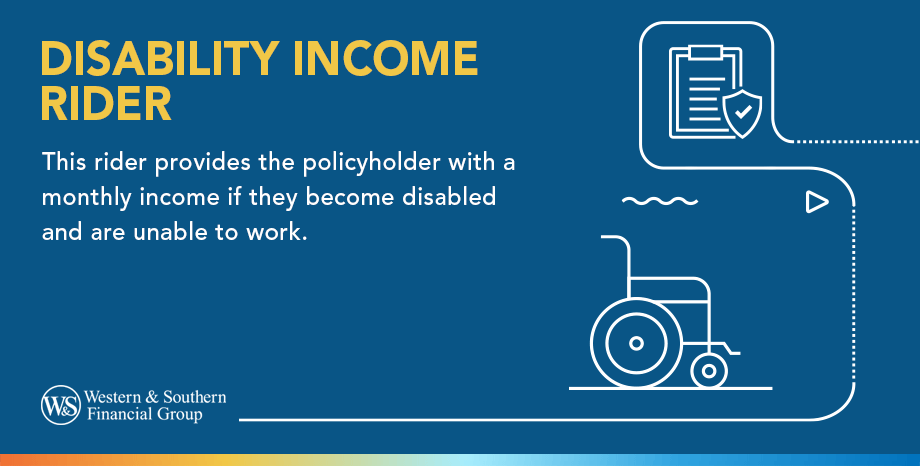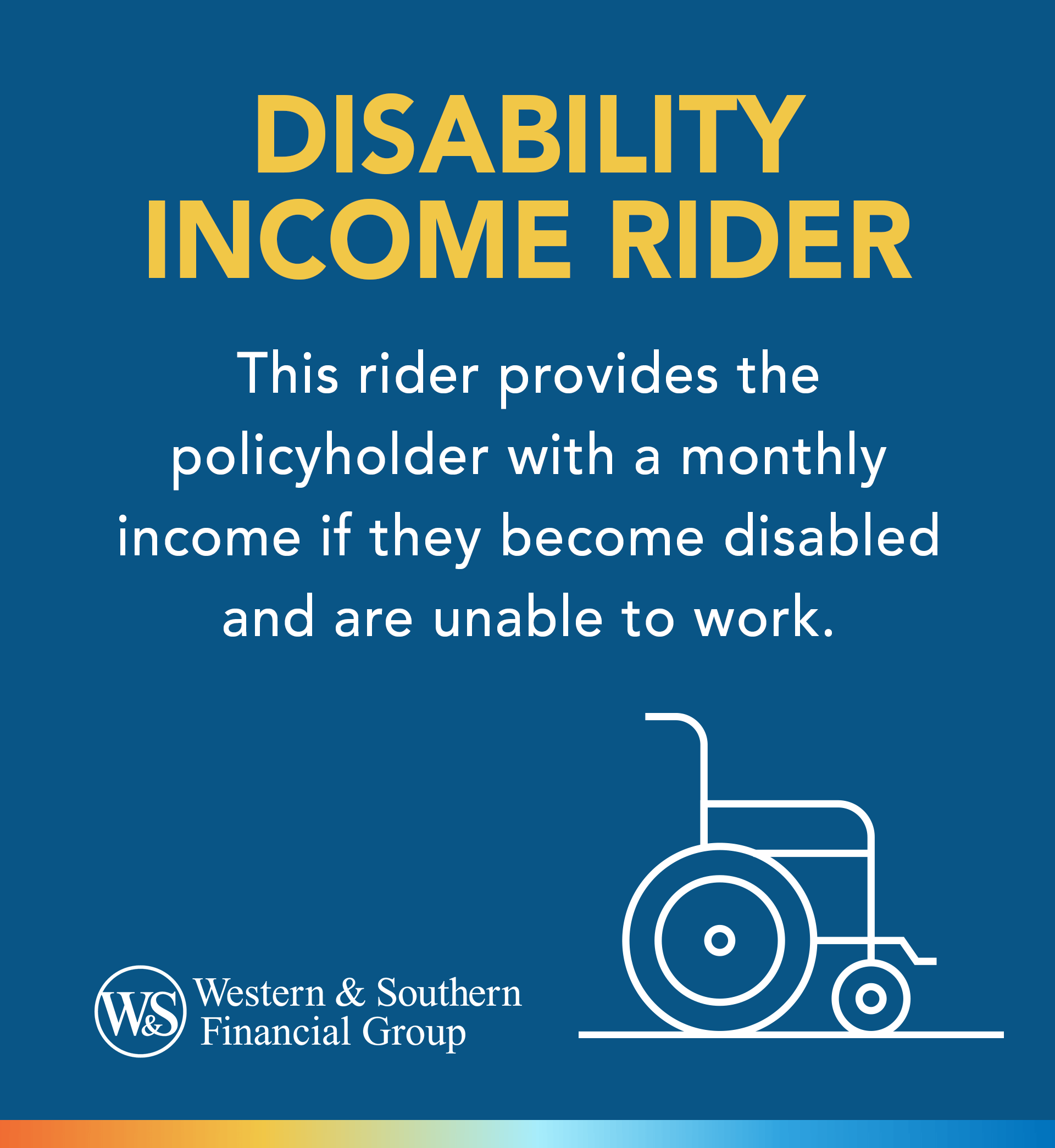

A disability income rider is an optional provision in a life insurance policy that provides a monthly income benefit if the insured person becomes disabled and can no longer work. The benefit is typically a percentage of the policy's face amount, and it is paid until the insured person reaches retirement age or dies, whichever comes first.
Updated May 8, 2024

A Disability Income Rider, also known as a Disability Income Benefit Rider, is an optional add-on to a life insurance policy that replaces a portion of the policyholder's income if they are disabled, ensuring a source of income during the period of disability.
A Disability Income Rider can be added to permanent life insurance policies such as whole life insurance or universal life insurance. Depending upon the life insurance company, it may also be added to a term life insurance policy.
Understanding what a Disability Income Rider is has significant implications for those seeking comprehensive protection through their life insurance policies. This rider is an essential financial safety net during challenging times by providing a life insurance living benefit.
Both a disability income rider and disability insurance protect against the loss of income and financial implications of disability.
A disability income rider is an add-on to an existing policy, often a life insurance policy, providing additional protection against income loss due to disability. A disability income rider is an additional coverage provision or endorsement that can be added to a primary insurance policy. Adding a rider to an existing standard life insurance policy might be more cost-effective than purchasing a separate disability insurance policy.
Disability insurance is a standalone policy and offers more comprehensive coverage specifically designed to replace a portion of your income if you become disabled and cannot work. Depending on the policy, it can be categorized as short-term disability insurance (often covering up to 6 months) or long-term disability insurance (covering several years or even up to retirement age).
The disability income rider and the waiver of premium rider are provisions that can be added to an insurance policy to provide additional benefits in the event of a disability.
The disability income rider provides the policyholder with a source of income during a disability, while the waiver of premium rider ensures the primary insurance policy remains in effect without the policyholder having to pay premiums during a period of disability.
They address different financial challenges associated with disability: loss of income and the ability to maintain insurance coverage, respectively.
The primary purpose of a disability income rider is to provide the policyholder with a monthly income if they become disabled and are unable to work. It acts as an income replacement tool during the period of disability. This rider typically pays out benefits until the insured person reaches retirement age or until the end of a predetermined benefit period, whichever comes first.
An impairment rider, sometimes called an exclusion rider, specifies conditions or pre-existing medical conditions that are not covered by the insurance policy. It excludes certain risks from the coverage, meaning the insurance company Will not pay benefits for claims related to the specified impairment. Impairment riders are typically associated with disability insurance policies.
Here's how the Disability Income Rider generally works:
Purchase: When purchasing or modifying a life insurance policy, the policyholder can add a Disability Income Rider for an additional cost. The disability income benefit rider's terms and costs depend on the insurance company and policy.
Activation: This rider is activated when the policyholder becomes disabled according to the terms and definitions stipulated in the insurance policy. If the policyholder can't work due to illness or injury that meets the policy's definition of disability, they can file a claim for benefits.
Waiting Period: After claiming disability, there's typically a waiting or elimination period during which the policyholder won't receive any benefits. This period could range from a month to several months.
Benefits: After the waiting period, the insurance company makes monthly disability income payments to the policyholder. These payments are predetermined and either a set amount or based on a percentage of the policyholder's usual income.
Duration: The benefits are generally paid for the duration of the disability or until the end of a predetermined benefit period, whichever comes first. For instance, a rider might stipulate benefits for 2 years, 5 years, or until the policyholder reaches a certain age.
End of Benefits: Once the policyholder can return to work or no longer meets the policy's definition of disability, the monthly benefit payments stop. Also, if the predetermined benefit period expires while the policyholder is still disabled, the benefits will cease.
Tax Implications: Depending on how the premiums for the rider are paid and the local tax laws, the benefits from a disability income rider might be tax-free or taxable. For instance, in many jurisdictions, the benefits received are typically tax-free if the premiums are paid with after-tax dollars (i.e., the premiums are not tax-deductible).
Continuation of Insurance Policy: Many disability income riders also include provisions that waive the monthly payment of the main insurance policy premiums while the policyholder receives disability benefits. This means the main life insurance policy remains in force without needing premium payments during the disability period.
It's important to note that the specifics of a life insurance policy's death benefit and life insurance riders can vary depending on the insurance company and the specific policy terms and conditions. Always review the policy's details and consult with an insurance professional to fully understand life insurance options' benefits, limitations, and costs.
"Own occupation" and "any occupation" are essential definitions within Disability Income Riders. They pertain to the criteria by which an individual is deemed "disabled" and eligible for benefits. Understanding the distinction between these two is crucial.
The Disability Income Rider is typically available to anyone eligible for a life insurance policy. However, the specific eligibility criteria can depend on several factors, including the insurance company's underwriting guidelines, the type and term of the policy, and the laws and regulations in your location. Here are some common factors that insurers may consider:
In all cases, it's essential to be transparent and provide accurate information during the application process. Misrepresentations or omissions can lead to denials of claims later on.
Check your availability for disability income protection. Get a Life Insurance Quote
A Disability Income Rider offers several benefits. Here are the primary advantages:
While these benefits make a disability income rider attractive, policyholders must understand the terms and conditions, including any limitations or exclusions. As with any financial product, consulting with a financial advisor or insurance professional is beneficial to ensure the disability income rider works and meets individual needs and expectations.
While a Disability Income Rider offers valuable protection, there are potential drawbacks or limitations to consider:
Given these policy benefits and potential drawbacks, it's crucial for individuals to carefully review the terms of a Disability Income Rider, consult with a licensed insurance agent, and weigh the pros and cons to determine if it's the right fit for their needs and financial situation.
Several factors influence the cost of a Disability Income Rider and can vary among most insurance companies and providers. Here's a breakdown of the considerations that may affect its cost:
The Insurer: Insurance companies price their products differently based on their underwriting guidelines and risk assessment models.
The Policyholder: Age, health, lifestyle, occupation, and whether or not you smoke can all affect the cost of a life insurance premium, and this carries over into the cost of a Disability Income Rider as well.
The Policy and Rider: The life insurance policy's term length and coverage amount will affect the cost. Longer durations, more significant benefit amounts, definition of disability, and frequency of payments usually mean higher costs for the full life insurance coverage and rider.
While the Disability Income Rider offers a valuable layer of protection, its cost can be influenced by a mix of factors tied to the policyholder and the insurance provider. As such, it's crucial to balance the need for the added protection it provides with the additional cost of life insurance premiums.
Whether a Disability Income Rider is worth it depends on individual circumstances, needs, and priorities. Here are some considerations to help evaluate its value:
Probability of Disability: Consider your risk of becoming disabled. Occupational hazards, lifestyle, and personal health history can influence this risk.
Current Financial Situation: Do you have sufficient savings or other sources of income (like a partner or family members' income) to sustain you if you cannot work for an extended period? Can you cover medical expenses?
Other Coverage: Do you already have disability coverage through your employer or another policy? Do you qualify for social security disability benefits? If so, is it adequate?
Cost vs. Benefit: Weigh the cost of the rider against the potential benefit. Consider how the additional premium impacts your budget and whether the cash value of the potential payout from the life insurance rider justifies this cost.
Length of Coverage: Some disability riders might only offer benefits for a limited time, like two or five years. If your disability claim lasts longer, do you have a plan for when those benefits stop?
Definitions and Exclusions: Understand the policy's definition of disability and any exclusions. If the terms are too restrictive, the rider's value decreases.
As with all financial decisions, discussing your options with a financial advisor or insurance professional is recommended. They can help you evaluate the costs and benefits of financial protection based on your specific needs and goals.
Remember that various types of life insurance policies and optional life insurance riders may suit your needs and financial situation. It is important to take the time to thoroughly research buying life insurance and consider all available options, taking into account your financial objectives, family, other life events, and personal preferences.
Evaluate if disability income aligns with your personal financial goals. Get a Life Insurance Quote
Plan for the Unexpected Understand your disability income options.














Information provided is general and educational in nature, and all products or services discussed may not be provided by Western & Southern Financial Group or its member companies (“the Company”). The information is not intended to be, and should not be construed as, legal or tax advice. The Company does not provide legal or tax advice. Laws of a specific state or laws relevant to a particular situation may affect the applicability, accuracy, or completeness of this information. Federal and state laws and regulations are complex and are subject to change. The Company makes no warranties with regard to the information or results obtained by its use. The Company disclaims any liability arising out of your use of, or reliance on, the information. Consult an attorney or tax advisor regarding your specific legal or tax situation.
![]()
Monday - Friday | 8 a.m. - 6 p.m. ET
Saturday | Closed
Sunday | Closed
Holidays | Closed
© 2017-2024 Western & Southern Financial Group, Inc.
Western & Southern is the marketing name for a group of diversified financial services businesses composed of Western & Southern Financial Group and its seven life insurance subsidiaries. Life insurance and annuity products may be issued by The Western and Southern Life Insurance Company, Western-Southern Life Assurance Company, Columbus Life Insurance Company, Integrity Life Insurance Company, The Lafayette Life Insurance Company, National Integrity Life Insurance Company or Gerber Life Insurance Company. Products and services referenced in this website are provided through multiple companies. Each company has financial responsibility only for its own products and services, and is not responsible for the products and services provided by the other companies. Not all products and services are available in all states. All companies are members of Western & Southern Financial Group and are located in Cincinnati, OH with the exception of National Integrity and Gerber Life, which are located in White Plains, NY.
This site is intended to provide a general overview of our products and services. Please review the details of each product with your financial representative to determine which options may best fit your needs.
Western & Southern Financial Group does not provide tax or legal advice. Please contact your tax or legal advisor regarding your situation. The information provided is for educational purposes only.
1 Superior ability to meet ongoing insurance obligations (second highest of 13 ratings; rating held since June 2009 for six out of seven of Western & Southern Financial Group’s life insurance subsidiaries, rating held since February 2024 for Gerber Life). Gerber Life is not rated by other rating agencies.
2 Very strong financial security characteristics (fourth highest of 21 ratings; rating held since August 2018)
3 Very strong capacity to meet policyholder and contract obligations on a timely basis (third highest of 21 ratings; rating held since June 2009)
4 Excellent financial security (fourth highest of 21 ratings; rating held since February 2009)
5 The Comdex Ranking is a composite of all the ratings a company has received from the major rating agencies. It ranks insurers on a scale of 1 to 100 (where 1 is the lowest) in an effort to reduce confusion over ratings because each rating agency uses a different scale.
Financial strength ratings apply to the individual member insurance companies affiliated with Western & Southern. Gerber Life is rated only by A.M. Best. The Lafayette Life Insurance Company is not rated by Moody’s.
This may contain information obtained from third-parties, including ratings from credit ratings agencies such as Standard & Poor’s. Reproduction and distribution of third-party content in any form is prohibited except with the prior written permission of the related third-party. Third-party content providers do not guarantee the accuracy, completeness, timeliness or availability of any information, including ratings, and are not responsible for any errors or omissions (negligent or otherwise), regardless of the cause, or for the results obtained from the use of such content. THIRD-PARTY CONTENT PROVIDERS GIVE NO EXPRESS OR IMPLIED WARRANTIES, INCLUDING, BUT NOT LIMITED TO, ANY WARRANTIES OF MERCHANTABILITY OR FITNESS FOR A PARTICULAR PURPOSE OR USE. THIRD-PARTY CONTENT PROVIDERS SHALL NOT BE LIABLE FOR ANY DIRECT, INDIRECT, INCIDENTAL, EXEMPLARY, COMPENSATORY, PUNITIVE, SPECIAL OR CONSEQUENTIAL DAMAGES, COSTS, EXPENSES, LEGAL FEES OR LOSSES (INCLUDING LOST INCOME OR PROFITS AND OPPORTUNITY COSTS OR LOSSES CAUSED BY NEGLIGENCE) IN CONNECTION WITH ANY USE OF THEIR CONTENT, INCLUDING RATINGS. Credit ratings are statements of opinions and are not statements of fact or recommendations to purchase, hold or sell securities. They do not address the suitability of securities or the suitability of securities for investment purposes, and should not be relied on as investment advice. Ratings are subject to change from time to time. The ratings shown here are correct as of February 20, 2024.
Gerber Life Insurance is a trademark. Used under license from Société des Produits Nestlé S.A. and Gerber Products Company.